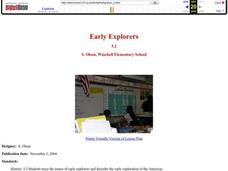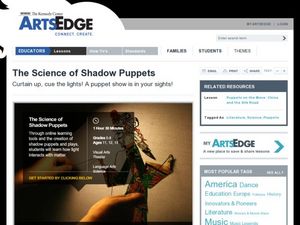Curated OER
Immigration: Stories of Yesterday and Today
Students use Web technology to access immigration history and develop an understanding of the concept of immigration. Then they develop oral history writing skills, including note-taking and conducting an interview and read for detail....
Curated OER
Making the Right Choice
Students, after discussing and brainstorming a variety of character traits, prepare to incorporate the traits into their own lives. They create, design and present an Interactive PowerPoint presentation with problem solving skills and...
Curated OER
Historical Figure: A Monologue
Fourth graders develop their speaking skills. In this monologue lesson, 4th graders watch their instructors model a monologue regarding Abraham Lincoln. Students apply these skills as they research a historical figure from their state...
Alabama Learning Exchange
Edible Cell
Students identify cell parts and their function. In this animal cell lesson, students view a video clip and discuss cell components. Students create an edible replica of an animal cell using food items.
Curated OER
Johnny Appleseed or John Chapman: Which Character is Your Favorite?
Students study the life of John Chapman and compare it with the fictional character, Johnny Appleseed. Students listen to books about Johnny Appleseed, and watch a video and PowerPoint if available. They make a KWL chart, make an online...
Curated OER
Documenting an Historic Journey
Students read and analyze journals written by Lewis and Clark. They watch and discuss a video segment, complete a graphic organizer, and write a journal entry written from the point of view of someone involved with the Lewis and Clark...
Curated OER
Exploring Pioneer America
Fourth graders research pioneers who had a strong influence on westward expansion. In this westward expansion lesson, 4th graders write an essay about four pioneers and an interview script about one. Students work in pairs to present...
Alabama Learning Exchange
We Can Dig It!
Third graders understand the process by which fossils and rocks are excavated. For this fossil and rock lesson, 3rd graders explore the job of the paleontologist in a podcast.
Curated OER
Early Explorers
Fifth graders give a presentation about one of the explorers. In this explorers activity, 5th graders research an explorer and give a presentation to the class. While students are presenting the others are taking notes on a graphic...
Curated OER
Function of a Stem
Fourth graders perform an experiment to test the function of a stem. In this science activity, 4th graders write a description of their investigations. Students also explain how the stem interacts with the rest of the plant. Students use...
Curated OER
Science Notebooks
Teachers can use science notebooks and other forms of writing to help students improve their understanding of scientific concepts.
Curated OER
Portrait of a Place, Portrait of a Family
Learners act out stories based on lives of famous people from Harlem. In this memoirs lesson, students compare the life of the people in Harlem in 1930 to the people of today. Learners explore how "home" is different for different...
Curated OER
Olympic Athletes and Moments in Time
Students examine the history of the Olympics and their athletes. For this interviewing skills lesson, students role play the parts of reporters and athletes as they conduct interviews based on research of the Olympic games and athletes.
Curated OER
Percentages: Fractions and Decimals
Second graders convert fractions to percentages. In this interactive whiteboard percentages lesson, 2nd graders problem solve using percentages, fractions, and decimals.
Curated OER
Halloween Literature Unit: Little Critter’s Halloween
Students are read Happy Halloween Little Critter, by Mercer Mayer. In this emotions lesson, students discover how their mood is often affected by their feelings. They discuss the story as a class and then work independently on a...
Curated OER
Short Vowels With Clifford
Phonetic masters identify and recognize short vowel sounds by reading and listening to a story that highlights select words. They use picture clues to aid comprehension and construct a story by actively choosing and identifying...
Curated OER
Holes
Students read and analyze the story elements of the novel "Holes" by Louis Sachar. They play a "Holes" matching game, complete a timeline of story events, complete a Cause-and-Effect graphic organizer, conduct research on Louis Sachar's...
Curated OER
Discovering Peace
Students explore vocabulary related to peace. In this peace lesson, students define the word "peace" and create a poem about peace. Students create a "peace quilt" as a follow-up activity.
Curated OER
Jamestown
Seventh graders examine life at the Jamestown settlement. In this colonial America instructional activity, 7th graders visit the noted Web site to analyze artifacts from the settlement. Based on their findings, students write descriptive...
Curated OER
What do two-dimensional tessellations look like? Where in art can they be found?
Students explore the world of art and culture, including the works of M.C. Escher. They identify and create original tessellations. Students use a wealth of interactive multimedia applications. They explore the artistic representations...
Curated OER
Making a Quilt
Students use vocabulary to describe the quilt making process. In this quilting instructional activity, students collect needed materials, sequence the steps for quilting and create an original peace quilt. Students write about their quilts.
Curated OER
The Science of Shadow Puppets
Students explore the art of shadow puppetry. In this performing arts lesson, students study the functions of lighting in the puppet theater as they examine the transmission, absorption, and reflection of light. As a culminating activity,...
Curated OER
The Dirt on Worms!
Fourth graders make predictions, observe, collect and record data. They investigate several soil and worm websites. Finally, 4th graders write a letter to The President which defends earthworms by explaining their value to the United...
Curated OER
Read to Feed
Students participate in the Read-to-Feed project. In this fundraising lesson, students read books to purchase a farm animal for a family in need. Students write a letter to the family that will be receiving the farm animal.
























